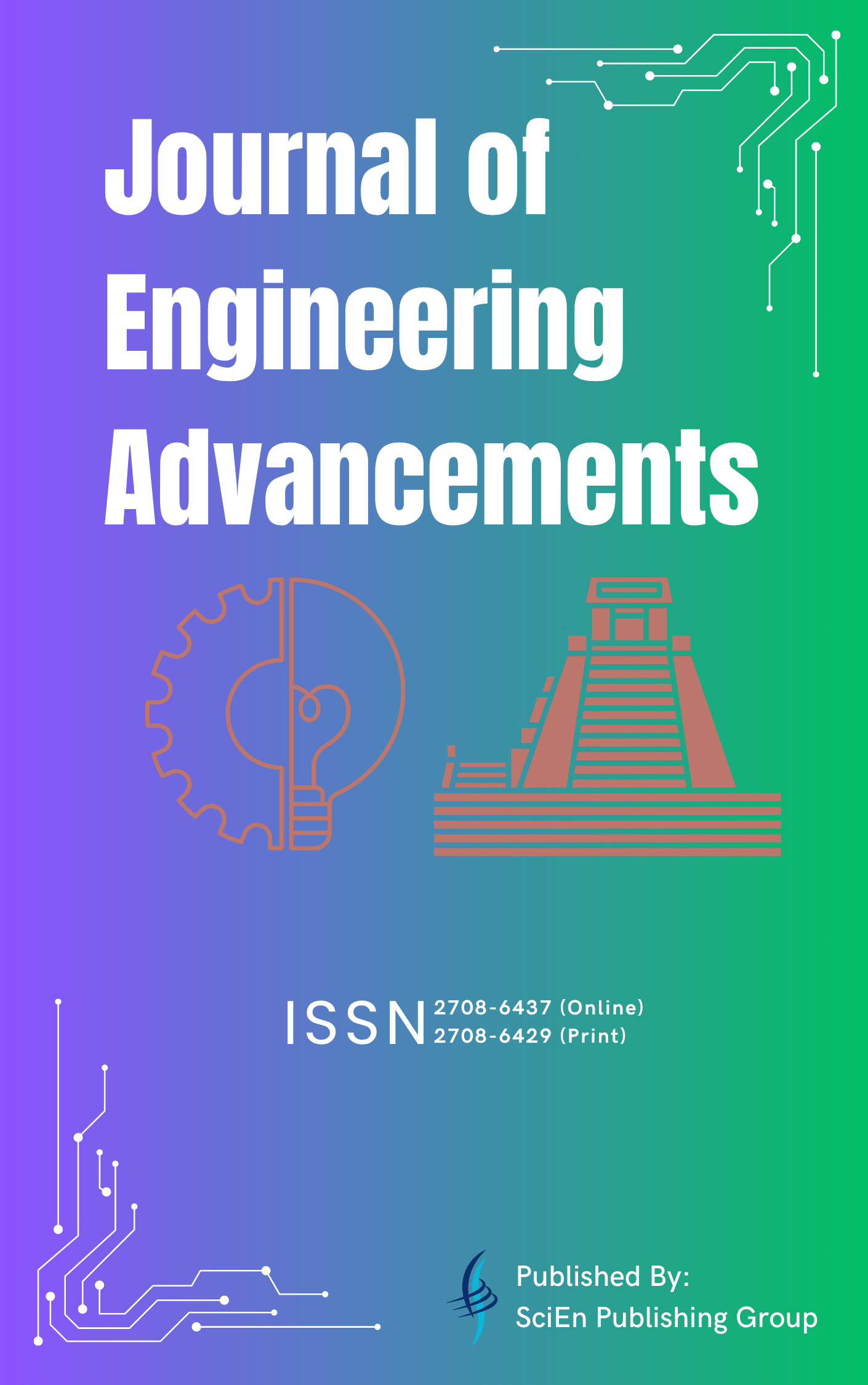Morphological Characterization of Bio-Mediated Silver Nanoparticles from Azadirachta Indica (Neem) Leaf Extract
DOI:
https://doi.org/10.38032/scse.2025.2.6Keywords:
Green synthesis, Azadirachta Indica, Plant extract, Silver nanoparticlesAbstract
A facile, low cost and environment-friendly synthesis process of nanoparticles is very necessary due to the increasing concern for the environment. In this study, silver nanoparticles (AgNPs) were prepared from silver nitrate precursors using leaves from Azadirachta Indica plant, also referred to as the Neem tree. The presence of phytochemicals (alkaloids, flavonoids, proteins, terpenoids, etc.) in Azadirachta Indica leaf extract was mainly responsible to synthesis AgNPs. For the preparation of Azadirachta Indica leaf extract mediated silver nanoparticles (A.I-AgNPs), the synthesis parameters were chosen for pH 8, time 1.5 hrs, temperature 70ºC, plant extract: silver nitrate 1:8. The as-prepared A.I-AgNPs were characterized by ultraviolet-visible (UV-vis) spectroscopy, field emission scanning electron microscopy (FE-SEM), energy-dispersive x-ray spectroscopy (EDX), and Fourier transform infrared spectroscopy (FTIR) analysis. After the addition of plant extract into the silver nitrate solution, the color of the reaction mixture was changed from yellow to brown to dip brown which was the visual confirmation of silver nanoparticles formation. The surface plasmon resonance (SPR) characteristic of A.I-AgNPs was analyzed by UV–vis spectrophotometer test. The SPR peak was found at 460nm which confirmed the successful formation of silver nanoparticles. The FE-SEM analysis revealed that most of the nanoparticles are spherical in shape with the size ranging from 45nm to 111nm (average 84nm). EDX analysis showed an intense peak at 3KeV that strongly proved the presence of silver elements. FTIR analysis of the synthesized silver nanoparticles confirmed the presence of different functional groups on the A.I-AgNPs surface which ensured the successful reduction and capping of silver nanoparticles. The successful preparation of A.I-AgNPs suggested that the chosen synthesis parameters can be further used to prepare AgNPs for various applications.
Downloads
Downloads
Downloads
References
[1] Moteriya, P., Chanda, S., Green Synthesis of Silver Nanoparticles from Caesalpinia pulcherrima Leaf Extract and Evaluation of Their Antimicrobial , Cytotoxic and Genotoxic Potential ( 3-in-1 System ), Journal of Inorganic and Organometallic Polymers and Materials, Vol. 30, pp. 3920-3932, 2020. DOI: https://doi.org/10.1007/s10904-020-01532-7
[2] Mandal, A., Ray Banerjee, E., Introduction to Nanoscience, Nanotechnology and Nanoparticles, E. Ray Banerjee (Ed.), Nanomaterials and Biomedicine, Springer Singapore, Singapore, 1-39. 2020 DOI: https://doi.org/10.1007/978-981-15-5274-8_1
[3] Madkour, L. H., Introduction to Nanotechnology (NT) and Nanomaterials (NMs), Advanced Structured Materials, Vol. 116, pp. 1-47, 2019 DOI: https://doi.org/10.1007/978-3-030-21621-4_1
[4] Dong, X. Y., Gao, Z. W., Yang, K. F., Zhang, W. Q., Xu, L. W., Nanosilver as a new generation of silver catalysts in organic transformations for efficient synthesis of fine chemicals, Catalysis Science and Technology, Vol. 5, pp. 2554-2574, 2015 DOI: https://doi.org/10.1039/C5CY00285K
[5] Yousaf, H., Mehmood, A., Ahmad, K. S., Raffi, M., Green synthesis of silver nanoparticles and their applications as an alternative antibacterial and antioxidant agents, Materials Science and Engineering: C, Vol. 112, pp. 110901, 2020 DOI: https://doi.org/10.1016/j.msec.2020.110901
[6] Ahmed, T., Ogulata, R. T., A Review on Silver Nanoparticles -green Synthesis, Antimicrobial Action and Application in Textiles, Journal of Natural Fibers, pp.1-22, 2021 DOI: https://doi.org/10.1080/15440478.2021.1964135
[7] Hasan, M., Ullah, I., Zulfiqar, H., Naeem, K., Iqbal, A., Gul, H., Ashfaq, M., Mahmood, N., Biological entities as chemical reactors for synthesis of nanomaterials: Progress, challenges and future perspective, Materials Today Chemistry, Vol. 8, pp. 13-28, 2018 DOI: https://doi.org/10.1016/j.mtchem.2018.02.003
[8] Rafique, M. S., Sadaf, I., Rafique, M. S., Tahir, M. B., A review on green synthesis of silver nanoparticles and their applications, Artificial Cells, Nanomedicine and Biotechnology, Vol. 45, pp. 1272-1291,2016. DOI: https://doi.org/10.1080/21691401.2016.1241792
[9] Umar, Z., Bello, U. R., Mathur, A., Tailor, G., Chaudhary, J., Singh, S., Modulation of Biofilm with synthesized silver nanoparticles from Azadirachta indica, Current Research in Green and Sustainable Chemistry, Vol. 4, 2021. DOI: https://doi.org/10.1016/j.crgsc.2021.100203
[10] Kumar, S., Basumatary, I. B., Sudhani, H. P. K., Bajpai, V. K., Chen, L., Shukla, S., Mukherjee, A. , Plant extract mediated silver nanoparticles and their applications as antimicrobials and in sustainable food packaging: A state-of-the-art review, Trends in Food Science & Technology, Vol. 112,pp. 651-666, 2021 DOI: https://doi.org/10.1016/j.tifs.2021.04.031
[11] Logaranjan, K., Raiza, A. J., Gopinath, S. C. B., Chen, Y., Pandian, K. , Shape- and Size-Controlled Synthesis of Silver Nanoparticles Using Aloe vera Plant Extract and Their Antimicrobial Activity, Nanoscale Research Letters, 2016 DOI: https://doi.org/10.1186/s11671-016-1725-x
[12] Manik, U. P. P., Nande, A., Raut, S., Dhoble, S. J. J., Green synthesis of silver nanoparticles using plant leaf extraction of Artocarpus heterophylus and Azadirachta indica, Results in Materials, Vol. 6, pp. 100086, 2020 DOI: https://doi.org/10.1016/j.rinma.2020.100086
[13] Seifipour, R., Nozari, M., Pishkar, L., Green Synthesis of Silver Nanoparticles using Tragopogon Collinus Leaf Extract and Study of Their Antibacterial Effects, Journal of Inorganic and Organometallic Polymers and Materials, Vol. 30,pp. 2926-2936, 2020. DOI: https://doi.org/10.1007/s10904-020-01441-9
[14] Kumar, V., Bano, D., Mohan, S., Singh, D. K., Hasan, S. H., Sunlight-induced green synthesis of silver nanoparticles using aqueous leaf extract of Polyalthia longifolia and its antioxidant activity, Materials Letters, Vol. 181, pp. 371-377, 2016 DOI: https://doi.org/10.1016/j.matlet.2016.05.097
[15] Anandalakshmi, K., Venugobal, J., Ramasamy, V., Characterization of silver nanoparticles by green synthesis method using Pedalium murex leaf extract and their antibacterial activity, Applied Nanoscience, Vol. 6, pp. 399-408, 2016 DOI: https://doi.org/10.1007/s13204-015-0449-z
[16] Costa, J. J., Hosseinzadeh, H., Saha, D. K., Mahmud, S. U. Al, Uddin, B. M. M., Ratan, Z. A., Green Synthesis of Silver Nanoparticles using Citrus aurantifolia (Bangladeshi Lemon Leaf) Extract and Its Antibacterial Activity, 2021 IEEE International Biomedical Instrumentation and Technology Conference (IBITeC), IEEE, pp. 29-32, 2021 DOI: https://doi.org/10.1109/IBITeC53045.2021.9649155
[17] El-Seedi, H. R., El-Shabasy, R. M., Khalifa, S. A. M., Saeed, A., Shah, A., Shah, R., Iftikhar, F. J., Abdel-Daim, M. M., Omri, A., Hajrahand, N. H., Sabir, J. S. M., Zou, X., Halabi, M. F., Sarhan, W., Guo, W., Metal nanoparticles fabricated by green chemistry using natural extracts: biosynthesis, mechanisms, and applications, RSC Advances, Vol. 9, pp. 24539-24559, 2019 DOI: https://doi.org/10.1039/C9RA02225B
[18] Akintelu, S. A., Olugbeko, S. C., Folorunso, A. S., Oyebamiji, A. K., Folorunso, F. A., Potentials of phytosynthesized silver nanoparticles in biomedical fields: a review, International Nano Letters, Vol. 11, pp. 273-293, 2021 DOI: https://doi.org/10.1007/s40089-021-00341-1
[19] Gupta, S. C., Prasad, S., Tyagi, A. K., Kunnumakkara, A. B., Aggarwal, B. B., Neem (Azadirachta indica): An indian traditional panacea with modern molecular basis, Phytomedicine, Vol. 34, pp.14-20, 2017. DOI: https://doi.org/10.1016/j.phymed.2017.07.001
[20] Islas, J. F., Acosta, E., G-Buentello, Z., Delgado-Gallegos, J. L., Moreno-Treviño, M. G., Escalante, B., Moreno-Cuevas, J. E., An overview of Neem (Azadirachta indica) and its potential impact on health, Journal of Functional Foods, Vol. 74, pp.104171, 2020 DOI: https://doi.org/10.1016/j.jff.2020.104171
[21] Liu, H., Zhang, H., Wang, J., Wei, J., Effect of temperature on the size of biosynthesized silver nanoparticle: Deep insight into microscopic kinetics analysis, Arabian Journal of Chemistry, Vol. 13,pp. 1011-1019, 2020 DOI: https://doi.org/10.1016/j.arabjc.2017.09.004
[22] Gull, A., Bhat, N., Wani, S. M., Masoodi, F. A., Amin, T., Ganai, S. A., Shelf life extension of apricot fruit by application of nanochitosan emulsion coatings containing pomegranate peel extract, Food Chemistry, Vol. 349, 2021. DOI: https://doi.org/10.1016/j.foodchem.2021.129149
[23] Dhar, S. A.; Chowdhury, R. A.; Das, S.; Nahian, M. K.; Islam, D.; Gafur, M. A. (2021). Plant-mediated green synthesis and characterization of silver nanoparticles using Phyllanthus emblica fruit extract, Materials Today: Proceedings, Vol. 42, 1867-1871. DOI: https://doi.org/10.1016/j.matpr.2020.12.222
[24] Pilaquinga, F., Amaguaña, D., Morey, J., Moncada-Basualto, M., Pozo-Martínez, J., Olea-Azar, C., Fernández, L., Espinoza-Montero, P., Jara-Negrete, E., Meneses, L., López, F., Debut, A., Piña, N., Synthesis of Silver Nanoparticles Using Aqueous Leaf Extract of Mimosa albida (Mimosoideae): Characterization and Antioxidant Activity, Materials, Vol. 13, pp. 503,2020. DOI: https://doi.org/10.3390/ma13030503
[25] Perveen, R., Shujaat, S., Naz, M., Qureshi, M. Z., Nawaz, S., Shahzad, K., Ikram, M., Green synthesis of antimicrobial silver nanoparticles with Brassicaceae seeds, Materials Research Express, Vol. 8, pp. 055007, 2021 DOI: https://doi.org/10.1088/2053-1591/ac006b
[26] Nguyen, V. P., Le Trung, H., Nguyen, T. H., Hoang, D., Tran, T. H., Synthesis of Biogenic Silver Nanoparticles with Eco-Friendly Processes Using Ganoderma lucidum Extract and Evaluation of Their Theranostic Applications, Journal of Nanomaterials, Vol. 2021, pp. 1-11, 2021 DOI: https://doi.org/10.1155/2021/6135920
[27] Mehata, M. S., Green route synthesis of silver nanoparticles using plants/ginger extracts with enhanced surface plasmon resonance and degradation of textile dye, Materials Science and Engineering B: Solid-State Materials for Advanced Technology, Vol. 273,pp. 115418, 2021. DOI: https://doi.org/10.1016/j.mseb.2021.115418
[28] Sandhir, R., Khurana, M., Singhal, N. K., Potential benefits of phytochemicals from Azadirachta indica against neurological disorders, Neurochemistry International, Vol. 146, pp. 105023, 2021 DOI: https://doi.org/10.1016/j.neuint.2021.105023
[29] Rajeshkumar, S., Bharath, L. V., Mechanism of plant-mediated synthesis of silver nanoparticles - A review on biomolecules involved, characterisation and antibacterial activity, Chemico-Biological Interactions, Vol. 273, pp. 219-227,2017. DOI: https://doi.org/10.1016/j.cbi.2017.06.019
[30] Alahmad, A., Feldhoff, A., Bigall, N. C., Rusch, P., Scheper, T., Walter, J.-G., Hypericum perforatum L.-Mediated Green Synthesis of Silver Nanoparticles Exhibiting Antioxidant and Anticancer Activities, Nanomaterials, Vol. 11, pp. 487, 2021 DOI: https://doi.org/10.3390/nano11020487
[31] Jana, J., Ganguly, M., Pal, T., Enlightening surface plasmon resonance effect of metal nanoparticles for practical spectroscopic application, RSC Advances, Vol. 6,pp. 86174-86211, 2016 DOI: https://doi.org/10.1039/C6RA14173K
[32] Ider, M., Abderrafi, K., Eddahbi, A., Ouaskit, S., Kassiba, A., Silver Metallic Nanoparticles with Surface Plasmon Resonance: Synthesis and Characterizations, Journal of Cluster Science, Vol. 28, pp. 1051-1069, 2017 DOI: https://doi.org/10.1007/s10876-016-1080-1
[33] Velmurugan, P., Hong, S. C., Aravinthan, A., Jang, S. H., Yi, P. I., Song, Y. C., Jung, E. S., Park, J. S., Sivakumar, S., Comparison of the Physical Characteristics of Green-Synthesized and Commercial Silver Nanoparticles: Evaluation of Antimicrobial and Cytotoxic Effects, Arabian Journal for Science and Engineering, Vol. 42, pp. 201-208, 2017. DOI: https://doi.org/10.1007/s13369-016-2254-8
[34] Veisi, H., Azizi, S., Mohammadi, P., Green synthesis of the silver nanoparticles mediated by Thymbra spicata extract and its application as a heterogeneous and recyclable nanocatalyst for catalytic reduction of a variety of dyes in water, Journal of Cleaner Production, Vol. 170, pp. 1536-1543, 2018 DOI: https://doi.org/10.1016/j.jclepro.2017.09.265
[35] Samari, F., Parkhari, P., Eftekhar, E., Mohseni, F., Yousefinejad, S., Antioxidant, cytotoxic and catalytic degradation efficiency of controllable phyto-synthesised silver nanoparticles with high stability using Cordia myxa extract, Journal of Experimental Nanoscience, Vol. 14, pp. 141-159, 2019. DOI: https://doi.org/10.1080/17458080.2019.1687883
[36] Murthy, H. C. A., Desalegn Zeleke, T., Ravikumar, C. R., Anil Kumar, M. R., Nagaswarupa, H. P., Electrochemical properties of biogenic silver nanoparticles synthesized using Hagenia abyssinica (Brace) JF. Gmel. medicinal plant leaf extract, Materials Research Express, Vol. 7, No. 5, 055016., 2020. DOI: https://doi.org/10.1088/2053-1591/ab9252
[37] Ali, E. M., Abdallah, B. M., Effective inhibition of candidiasis using an eco-friendly leaf extract of calotropis-gigantean-mediated silver nanoparticles, Nanomaterials, Vol. 10, No. 3, pp. 1-16, 2020. DOI: https://doi.org/10.3390/nano10030422
[38] Gommes, C. J., Ostwald ripening of confined nanoparticles: chemomechanical coupling in nanopores, Nanoscale, Vol. 11, No. 15, pp. 7386-7393, 2019. DOI: https://doi.org/10.1039/C9NR01349K
[39] Hamedi, S., Shojaosadati, S. A., Rapid and green synthesis of silver nanoparticles using Diospyros lotus extract: Evaluation of their biological and catalytic activities, Polyhedron, Vol. 171, pp. 172-180, 2019. DOI: https://doi.org/10.1016/j.poly.2019.07.010
[40] Jebril, S., Khanfir Ben Jenana, R., Dridi, C., Green synthesis of silver nanoparticles using Melia azedarach leaf extract and their antifungal activities: In vitro and in vivo, Materials Chemistry and Physics, Vol. 248, pp. 122898, 2020. DOI: https://doi.org/10.1016/j.matchemphys.2020.122898
Published
Conference Proceedings Volume
Section
License
Copyright (c) 2025 Tamal Krishna Paul, Mohammad Abdul Jalil, Pranto Kumar Mondal, Md Moniruzzaman, Md Abdul Alim, Kowshik Halder (Author)

This work is licensed under a Creative Commons Attribution 4.0 International License.
All the articles published by this journal are licensed under a Creative Commons Attribution 4.0 International License


